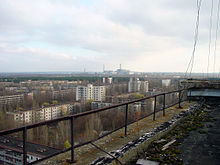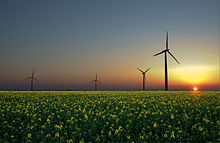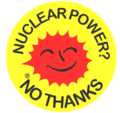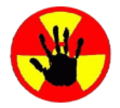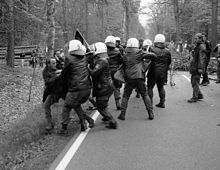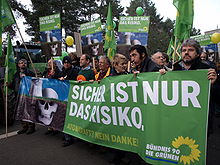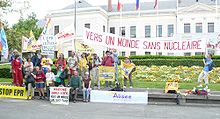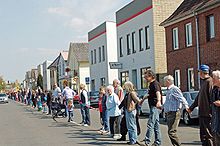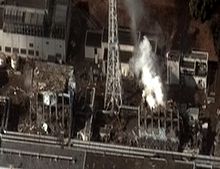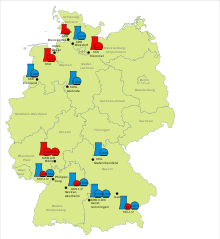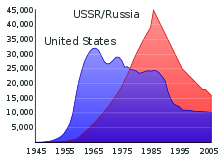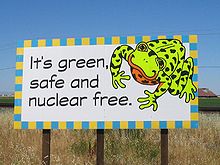- Anti-nuclear movement
-
 120,000 people attended an anti-nuclear protest in Bonn, Germany, on October 14, 1979, following the Three Mile Island accident.[1]
120,000 people attended an anti-nuclear protest in Bonn, Germany, on October 14, 1979, following the Three Mile Island accident.[1]
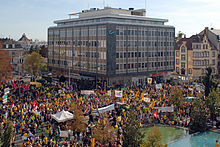 Anti-nuclear demonstration in Colmar, north-eastern France, on October 3, 2009.
Anti-nuclear demonstration in Colmar, north-eastern France, on October 3, 2009.
Anti-nuclear movement 
Australia · Austria · Canada
France · Germany · India
Japan · Kazakhstan · New Zealand
Philippines · Spain
Switzerland · Taiwan · Turkey
United Kingdom · United States
List of groups
List of protests by countryThe anti-nuclear movement is a social movement that opposes the use of nuclear technologies. Many direct action groups, environmental groups, and professional organisations[2][3] have identified themselves with the movement at the local, national, and international level. Major anti-nuclear groups include Campaign for Nuclear Disarmament, Friends of the Earth, Greenpeace, International Physicians for the Prevention of Nuclear War, and the Nuclear Information and Resource Service. The initial objective of the movement was nuclear disarmament, though the focus has shifted to include opposition to the use of nuclear power.
There have been many large anti-nuclear demonstrations and protests. A protest against nuclear power occurred in July 1977 in Bilbao, Spain, with up to 200,000 people in attendance. Following the Three Mile Island accident in 1979, an anti-nuclear protest was held in New York City, involving 200,000 people. In 1981, Germany's largest anti-nuclear power demonstration took place to protest against the Brokdorf Nuclear Power Plant west of Hamburg; some 100,000 people came face to face with 10,000 police officers. The largest anti-nuclear protest was held on June 12, 1982, when one million people demonstrated in New York City against nuclear weapons. A 1983 nuclear weapons protest in West Berlin had about 600,000 participants. In May 1986, following the Chernobyl disaster, an estimated 150,000 to 200,000 people marched in Rome to protest against the Italian nuclear program.
For many years after the 1986 Chernobyl disaster nuclear power was off the policy agenda in most countries, and the anti-nuclear power movement seemed to have won its case. Some anti-nuclear groups disbanded. In the 2000s, however, following public relations activities by the nuclear industry,[4][5][6][7] advances in nuclear reactor designs, and concerns about climate change, nuclear power issues came back into energy policy discussions in some countries. The 2011 Japanese nuclear accidents subsequently undermined the nuclear power industry's proposed renaissance and revived anti-nuclear passions worldwide, putting governments on the defensive.[8] As of June 2011, countries such as Australia, Austria, Denmark, Greece, Ireland, Italy, Latvia, Lichtenstein, Luxembourg, Malta, Portugal, Israel, Malaysia, New Zealand, and Norway remain opposed to nuclear power.[9][10] As of June 2011, Germany and Switzerland are phasing-out nuclear power.[10][11]
Contents
History and issues
Roots of the movement
Main article: History of the anti-nuclear movement Worldwide nuclear testing totals, 1945-1998.
Worldwide nuclear testing totals, 1945-1998.
The application of nuclear technology, both as a source of energy and as an instrument of war, has been controversial.[12][13][14][15][16]
Scientists and diplomats have debated nuclear weapons policy since before the atomic bombing of Hiroshima in 1945.[17] The public became concerned about nuclear weapons testing from about 1954, following extensive nuclear testing in the Pacific. In 1961, at the height of the Cold War, about 50,000 women brought together by Women Strike for Peace marched in 60 cities in the United States to demonstrate against nuclear weapons.[18][19] In 1963, many countries ratified the Partial Test Ban Treaty which prohibited atmospheric nuclear testing.[20]
Some local opposition to nuclear power emerged in the early 1960s,[21] and in the late 1960s some members of the scientific community began to express their concerns.[22] In the early 1970s, there were large protests about a proposed nuclear power plant in Wyhl, Germany. The project was cancelled in 1975 and anti-nuclear success at Wyhl inspired opposition to nuclear power in other parts of Europe and North America.[23][24] Nuclear power became an issue of major public protest in the 1970s.[25]
Anti-nuclear concerns
Concerns about nuclear weapons
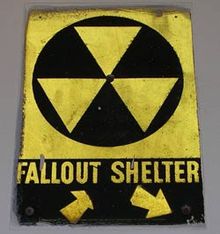 A sign pointing to an old fallout shelter in New York City.
A sign pointing to an old fallout shelter in New York City. See also: Nuclear weapons debate and Uranium mining debate
See also: Nuclear weapons debate and Uranium mining debateThe existential threat of nuclear war by accidental or deliberate nuclear strike is a pressing concern.[26] Also, many local communities are affected by nuclear weapons testing, uranium mining, and the disposal of radioactive waste.[26]
Ridding the world of nuclear weapons has been a cause of the pacifist left for a long time. But more recently mainstream politicians, retired military leaders, and academic strategists have begun to share the same goal. In January 2007 a seminal article appeared in the Wall Street Journal, authored by Henry Kissinger, Bill Perry, George Shultz and Sam Nunn. These men were veterans of the cold-war era with impeccable credentials as believers in using nuclear weapons for deterrence. But they now reversed their previous position and asserted that far from making the world safer, nuclear weapons had become a source of extreme risk:[27]
The risk of accidents, misjudgments or unauthorised launches, they argued, was growing more acute in a world of rivalries between relatively new nuclear states that lacked the security safeguards developed over many years by America and the Soviet Union. The emergence of pariah states, such as North Korea (possibly soon to be joined by Iran), armed with nuclear weapons was adding to the fear as was the declared ambition of terrorists to steal, buy or build a nuclear device. Only by a concerted effort to free the world of nuclear weapons could the terrifying trend be reversed.[27]
Some scientists estimate that a war between two countries that resulted in 100 Hiroshima-size atomic explosions would cause significant loss of life, in the tens of millions. There would also be much soot thrown up into the atmosphere which would blanket the earth, causing the disruption of food chains.[28][29]
Concerns about nuclear power
See also: Nuclear power debate, Lists of nuclear disasters and radioactive incidents, and Nuclear safetyThe abandoned city of Prypiat, Ukraine, following the 1986 Chernobyl disaster. The Chernobyl nuclear power plant is in the background.
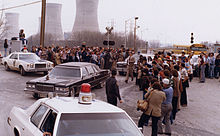 President Jimmy Carter leaving the Three Mile Island accident for Middletown, Pennsylvania, April 1, 1979.
President Jimmy Carter leaving the Three Mile Island accident for Middletown, Pennsylvania, April 1, 1979.
The public "perceives nuclear power as a very risky technology" and, around the world, nuclear energy has declined in popularity since the Fukushima Daiichi nuclear disaster.[31][32] Anti-nuclear critics see nuclear power as a dangerous, expensive way to boil water to generate electricity.[33] Opponents of nuclear power have raised a number of related concerns:[34]
- Nuclear accidents: a concern that the core of a nuclear power plant could overheat and melt down, releasing radioactivity.
- Radioactive waste disposal: a concern that nuclear power results in large amounts of radioactive waste, some of which remains dangerous for very long periods.
- Nuclear proliferation: a concern that the facilities and expertise to produce nuclear power can be readily adapted to produce nuclear weapons.
- High cost: a concern that nuclear power plants are very expensive.
- Nuclear terrorism: a concern that nuclear facilities could be targeted by terrorists or criminals.
- Curtailed civil liberties: a concern that the risk of nuclear accidents, proliferation and terrorism may be used to justify restraints on citizen rights.
Of these concerns, nuclear accidents and disposal of long-lived radioactive waste have probably had the greatest public impact worldwide.[34] Anti-nuclear campaigners point to the 2011 Fukushima nuclear emergency as proof that nuclear power can never be 100% safe.[35]
In his book Global Fission: The Battle Over Nuclear Power, Jim Falk explores connections between technological concerns and political concerns. Falk suggests that concerns of citizen groups or individuals who oppose nuclear power have often focused initially on the "range of physical hazards which accompany the technology". Concern often starts with a single issue, such as radioactive waste, but over time concerns usually spread and the focus broadens. Falk suggests that with a richer and more sophisticated understanding of issues comes more concerns and eventually, almost inevitably says Falk, this leads to a "concern over the political relations of the nuclear industry".[36] Falk argues that if all the different concerns over the physical hazards of nuclear power were distilled into one succinct statement, it might be this: "that it is a technology whose safety people deeply distrust". Falk says that that distrust also applies more widely, to the whole nuclear enterprise:[36]
People must have come not only to distrust the safety of the technology but also the authority of those who have assured them so confidently that nuclear power is safe. In this sense people distrust the entire nuclear enterprise -- not only its technology, but the public and private organizations, the political parties, and those often prestigious scientists who advocate and assist in the development of nuclear power.[36]
In 2010, Baruch Fischhoff, a social science professor said that many people really do not trust the nuclear industry. He stated that "although it hasn’t done anything recently to lose the general public’s trust, it hasn’t done anything to gain people’s trust".[37]
M.V. Ramana says that "distrust of the social institutions that manage nuclear energy is widespread", and a 2001 survey by the European Commission found that "only 10.1 percent of Europeans trusted the nuclear industry". This public distrust is periodically reinforced by safety violations by nuclear companies, or through ineffectiveness or corruption on the part of nuclear regulatory authorities. Once lost, says Ramana, trust is extremely difficult to regain.[38]
Faced with public antipathy, the nuclear industry has "tried a variety of strategies to persuade the public to accept nuclear power", including the publication of numerous "fact sheets" that discuss issues of public concern. M.V. Ramana says that none of these strategies have been very successful.[39]
Nuclear proponents have tried to regain public support by offering newer, safer, reactor designs. These designs include those that incorporate passive safety and Small Modular Reactors. While these reactor designs "are intended to inspire trust, they may have an unintended effect: creating distrust of older reactors that lack the touted safety features".[40]
Since 2000 the nuclear industry has undertaken an international media and lobbying campaign to promote nuclear power as a solution to the enhanced greenhouse effect and climate change.[41] Nuclear power, the industry claims, emits no or negligible amounts of carbon dioxide. Anti-nuclear groups respond by saying that only reactor operation is free of carbon dioxide emissions. All other stages of the nuclear fuel chain – mining, milling, transport, fuel fabrication, enrichment, reactor construction, decommissioning and waste management – use fossil fuels and hence emit carbon dioxide.[42][43][41]
In 2011, a French court fined Électricité de France (EDF) €1.5m and jailed two senior employees for spying on Greenpeace, including hacking into Greenpeace's computer systems. Greenpeace was awarded €500,000 in damages.[44] Although EDF claimed that a security firm had only been employed to monitor Greenpeace, the court disagreed, jailing the head and deputy head of EDF's nuclear security operation for three years each. Two employees of the security firm, Kargus, run by a former member of France's secret services, received sentences of three and two years respectively.[45]
Nuclear-free alternatives
See also: Soft energy path, Renewable energy commercialisation, Non-nuclear future, and The Clean Tech RevolutionAnti-nuclear groups generally claim that reliance on nuclear energy can be reduced by adopting energy conservation and energy efficiency measures. Energy efficiency can reduce the consumption of energy while providing the same level of energy "services".[46]
Anti-nuclear groups also favour the use of renewable energy, such as wind power, solar power, geothermal energy and biofuel.[47] According to the International Energy Agency, renewable energy technologies are essential contributors to the energy supply portfolio, as they contribute to world energy security and provide opportunities for mitigating greenhouse gases.[48] Fossil fuels are being replaced by clean, climate-stabilizing, non-depletable sources of energy:
...the transition from coal, oil, and gas to wind, solar, and geothermal energy is well under way. In the old economy, energy was produced by burning something — oil, coal, or natural gas — leading to the carbon emissions that have come to define our economy. The new energy economy harnesses the energy in wind, the energy coming from the sun, and heat from within the earth itself.[49]
Greenpeace advocates reduction of fossil fuels by 50% by 2050 as well as phasing out nuclear energy, contending that innovative technologies can increase energy efficiency, and suggests that by 2050 the majority of electricity will be generated from renewable sources.[47] The International Energy Agency estimates that nearly 50% of global electricity supplies will need to come from renewable energy sources in order to halve carbon dioxide emissions by 2050 and minimise significant, irreversible climate change impacts.[50]
Anti-nuclear organizations
See also: List of anti-nuclear groups, List of anti-nuclear power groups, and List of anti-nuclear groups in the United States Logo of the Nuclear Information and Resource Service
Logo of the Nuclear Information and Resource Service
The anti-nuclear movement is a social movement which operates at the local, national, and international level. Various types of groups have identified themselves with the movement:[3]
- direct action groups, such as the Clamshell Alliance and Shad Alliance;
- environmental groups, such as Friends of the Earth and Greenpeace;
- consumer protection groups, such as Ralph Nader's Critical Mass;
- professional organisations,[2] such as Union of Concerned Scientists and International Physicians for the Prevention of Nuclear War; and
- political parties such as European Free Alliance.
Anti-nuclear groups have undertaken public protests and acts of civil disobedience which have included occupations of nuclear plant sites. Other salient strategies have included lobbying, petitioning government authorities, influencing public policy through referendum campaigns and involvement in elections. Anti-nuclear groups have also tried to influence policy implementation through litigation and by participating in licencing proceedings.[51]
Anti-nuclear power organisations have emerged in every country that has had a nuclear power programme. Protest movements against nuclear power first emerged in the USA, at the local level, and spread quickly to Europe and the rest of the world. National nuclear campaigns emerged in the late 1970s. Fuelled by the Three Mile Island accident and the Chernobyl disaster, the anti-nuclear power movement mobilised political and economic forces which for some years "made nuclear energy untenable in many countries".[52]
Some of these anti-nuclear power organisations are reported to have developed considerable expertise on nuclear power and energy issues.[53] In 1992, the chairman of the Nuclear Regulatory Commission said that "his agency had been pushed in the right direction on safety issues because of the pleas and protests of nuclear watchdog groups".[54]
International organizations
- European Nuclear Disarmament, which held annual conventions in the 1980s involving thousands of anti-nuclear weapons activists mostly from Western Europe but also from Eastern Europe, the United States, and Australia.[55]
- Friends of the Earth International, a network of environmental organizations in 77 countries.[56]
- Global Zero, an international initiative launched in December 2008 to promote the elimination of nuclear weapons.
- Greenpeace International, a non-governmental environmental organization[57] with offices in 41 countries.[58]
- International Campaign to Abolish Nuclear Weapons
- International Physicians for the Prevention of Nuclear War, which had affiliates in 41 nations in 1985, representing 135,000 physicians;[55] IPPNW was awarded the UNESCO Peace Education Prize in 1984 and the Nobel Peace Prize in 1985.[59]
- Nuclear Information and Resource Service/ World Information Service on Energy
- Pax Christi International, a Catholic group which took a "sharply anti-nuclear stand".[55]
- Parliamentarians for Nuclear Non-Proliferation and Disarmament, a global network of over 700 parliamentarians from more than 75 countries working to prevent nuclear proliferation.[60]
- Ploughshares Fund
- Socialist International, the world body of social democratic parties.[61]
- Sōka Gakkai, a peace-orientated Buddhist organisation, which held anti-nuclear exhibitions in Japanese cities during the late 1970s, and gathered 10 million signatures on petitions calling for the abolition of nuclear weapons.[62][61]
- World Disarmament Campaign[61]
- World Union for Protection of Life
Selected other groups
Symbols
-
The Campaign for Nuclear Disarmament symbol, designed in 1958. It later became a universal peace symbol used in many different versions worldwide.[63]
-
The "Smiling Sun" icon of the anti-nuclear movement which came from the Danish anti-nuclear movement.[64]
Activities
Large protests
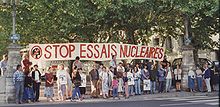 Demonstration in Lyon, France in the 1980s against nuclear tests
Demonstration in Lyon, France in the 1980s against nuclear tests Anti-nuclear demonstrations near Gorleben, Lower Saxony, Germany, 8 May 1996.
Anti-nuclear demonstrations near Gorleben, Lower Saxony, Germany, 8 May 1996. Main article: Anti-nuclear protests
Main article: Anti-nuclear protestsIn 1971, the town of Wyhl, in Germany, was a proposed site for a nuclear power station. In the years that followed, public opposition steadily mounted, and there were large protests. Television coverage of police dragging away farmers and their wives helped to turn nuclear power into a major issue. In 1975, an administrative court withdrew the construction licence for the plant.[23][24][65] The Wyhl experience encouraged the formation of citizen action groups near other planned nuclear sites.[23]
In 1972, the anti-nuclear weapons movement maintained a presence in the Pacific, largely in response to French nuclear testing there. Activists sailed small vessels into the test zone and interrupted the testing program.[66][67] In Australia, thousands joined protest marches in Adelaide, Melbourne, Brisbane, and Sydney. Scientists issued statements demanding an end to the tests. In Fiji, activists formed an Against Testing on Mururoa organization.[67]
In the Basque Country (Spain and France), a strong anti-nuclear movement emerged in 1973, which ultimately impeded the realisation of most of the planned nuclear power projects.[68] On July 14, 1977, in Bilbao, between 150,000 and 200,000 people protested against the Lemoniz Nuclear Power Plant. This has been called the "biggest ever anti-nuclear demonstration".[69]
In France there were a series of mass protests in the early seventies, organized at nearly every planned nuclear site in France. Between 1975 and 1977, some 175,000 people protested against nuclear power in ten demonstrations.[1] In 1977 there was a massive demonstration at the Superphénix breeder reactor in Creys-Malvillein which culminated in violence.[70]
In West Germany, between February 1975 and April 1979, some 280,000 people were involved in seven demonstrations at nuclear sites. Several site occupations were also attempted. In the aftermath of the Three Mile Island accident in 1979, some 120,000 people attended a demonstration against nuclear power in Bonn.[1]
In the Philippines, a focal point for protests in the late 1970s and 1980s was the proposed Bataan Nuclear Power Plant, which was built but never operated.[71]
In 1981, Germany's largest anti-nuclear power demonstration took place to protest against the construction of the Brokdorf Nuclear Power Plant on the North Sea coast west of Hamburg. Some 100,000 people came face to face with 10,000 police officers.[72][65][73]
In the late 1970s and early 1980s, the revival of the nuclear arms race, triggered a new wave of protests about nuclear weapons. Older organizations such as the Federation of Atomic Scientists revived, and newer organizations appeared, including the Nuclear Weapons Freeze Campaign and Physicians for Social Responsibility.[74] In the UK, on 1 April 1983, about 70,000 people linked arms to form a human chain between three nuclear weapons centres in Berkshire. The anti-nuclear demonstration stretched for 14 miles along the Kennet Valley.[75]
On Palm Sunday 1982, an estimated 100,000 Australians participated in anti-nuclear rallies in the nation's largest cities. Growing year by year, the rallies drew 350,000 participants in 1985.[67]
In May 1986, following the Chernobyl disaster, clashes between anti-nuclear protesters and West German police became common. More than 400 people were injured in mid-May at the site of a nuclear-waste reprocessing plant being built near Wackersdorf.[76] Also in May 1986, an estimated 150,000 to 200,000 people marched in Rome to protest against the Italian nuclear program, and 50,000 marched in Milan.[77] Hundreds of people walked from Los Angeles to Washington, D.C. in 1986 in what is referred to as the Great Peace March for Global Nuclear Disarmament. The march took nine months to traverse 3,700 miles (6,000 km), advancing approximately fifteen miles per day.[78]
The anti-nuclear organisation "Nevada Semipalatinsk" was formed in 1989 and was one of the first major anti-nuclear groups in the former Soviet Union. It attracted thousands of people to its protests and campaigns which eventually led to the closure of the nuclear test site at Semipalatinsk, in north-east Kazakhstan, in 1991.[79][80][81][82]
Protests in the United States
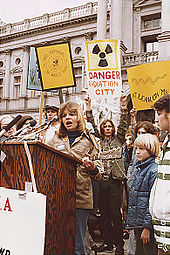 Anti-nuclear protest at Harrisburg, Pennsylvania, in 1979, following the Three Mile Island Accident.
Anti-nuclear protest at Harrisburg, Pennsylvania, in 1979, following the Three Mile Island Accident. Main article: Anti-nuclear protests in the United States
Main article: Anti-nuclear protests in the United StatesThere were many anti-nuclear protests in the United States which captured national public attention during the 1970s and 1980s. These included the well-known Clamshell Alliance protests at Seabrook Station Nuclear Power Plant and the Abalone Alliance protests at Diablo Canyon Nuclear Power Plant, where thousands of protesters were arrested. Other large protests followed the 1979 Three Mile Island accident.[83]
A large anti-nuclear demonstration was held in May 1979 in Washington D.C., when 65,000 people including the Governor of California, attended a march and rally against nuclear power.[84] In New York City on September 23, 1979, almost 200,000 people attended a protest against nuclear power.[85] Anti-nuclear power protests preceded the shutdown of the Shoreham, Yankee Rowe, Millstone I, Rancho Seco, Maine Yankee, and about a dozen other nuclear power plants.[86]
On June 12, 1982, one million people demonstrated in New York City's Central Park against nuclear weapons and for an end to the cold war arms race. It was the largest anti-nuclear protest and the largest political demonstration in American history.[87][88] International Day of Nuclear Disarmament protests were held on June 20, 1983 at 50 sites across the United States.[89][90] In 1986, hundreds of people walked from Los Angeles to Washington DC in the Great Peace March for Global Nuclear Disarmament.[91] There were many Nevada Desert Experience protests and peace camps at the Nevada Test Site during the 1980s and 1990s.[92][93]
Deaths and injuries
A few injuries have occurred during anti-nuclear protests:
- On 10 July 1985, the flagship of Greenpeace, Rainbow Warrior, was sunk by French agents in New Zealand waters, and a Greenpeace photographer was killed. The ship was involved in protests against nuclear weapons testing at Mururoa Atoll. The French Government initially denied any involvement with the sinking but eventually admitted its guilt in October 1985. Two French agents pleaded guilty to charges of manslaughter and the French Government paid $7 million in damages.[94]
- In 1990, two pylons holding high voltage power lines connecting the French and Italian grid were blown up by Italian eco-terrorists, and the attack is believed to have been directly in opposition against the Superphénix.[95]
- In 2004, a 23 year old activist who had tied himself to train tracks in front of a shipment of reprocessed nuclear waste was run over by the wheels of the train. The event happened in Avricourt, France and the fuel (totaling 12 containers) was from a German plant, on its way to be reprocessed.[96]
- On July 21, 2007, a Russian antinuclear activist was killed in a protest outside a future Uranium enrichment site. The victim was sleeping in a peace camp, which was part of the protest when it was attacked by unidentified raiders who beat activists who were sleeping, injuring eight and killing one. The protest group was self identified as anarchist and the assailants were suspected to be right wing.[97]
Recent developments
For many years after the 1986 Chernobyl disaster nuclear power was off the policy agenda in most countries, and the anti-nuclear power movement seemed to have won its case. Some anti-nuclear groups disbanded. In the 2000s, however, following public relations activities by the nuclear industry,[98][5][6][7] advances in nuclear reactor designs, and concerns about climate change, nuclear power issues came back into energy policy discussions in some countries. The 2011 Japanese nuclear accidents subsequently undermined the nuclear power industry's proposed renaissance and revived anti-nuclear passions worldwide, putting governments on the defensive.[99]
2004-2006
In January 2004, up to 15,000 anti-nuclear protesters marched in Paris against a new generation of nuclear reactors, the European Pressurised Water Reactor (EPWR).[100]
On May 1, 2005, 40,000 anti-nuclear/anti-war protesters marched past the United Nations in New York, 60 years after the atomic bombings of Hiroshima and Nagasaki.[101][102] This was the largest anti-nuclear rally in the U.S. for several decades.[103] In Britain, there were many protests about the government's proposal to replace the aging Trident weapons system with a newer model. The largest protest had 100,000 participants and, according to polls, 59 percent of the public opposed the move.[103]
2007-2009
 A scene from the 2007 Stop EPR (European Pressurised Reactor) protest in Toulouse, France.
A scene from the 2007 Stop EPR (European Pressurised Reactor) protest in Toulouse, France.
On March 17, 2007 simultaneous protests, organised by Sortir du nucléaire, were staged in five French towns to protest construction of EPR plants; Rennes, Lyon, Toulouse, Lille, and Strasbourg.[104][105]
In June 2007, 4,000 local residents, students and anti-nuclear activists took to the streets in the city of Kudus in Indonesia's Central Java, calling on the Government to abandon plans to build a nuclear power plant there.[106]
In February 2008, a group of concerned scientists and engineers called for the closure of the Kashiwazaki-Kariwa Nuclear Power Plant in Japan.[107][108]
The International Conference on Nuclear Disarmament took place in Oslo in February, 2008, and was organized by The Government of Norway, the Nuclear Threat Initiative and the Hoover Institute. The Conference was entitled Achieving the Vision of a World Free of Nuclear Weapons and had the purpose of building consensus between nuclear weapon states and non-nuclear weapon states in relation to the Nuclear Non-proliferation Treaty.[109]
During a weekend in October 2008, some 15,000 people disrupted the transport of radioactive nuclear waste from France to a dump in Germany. This was one of the largest such protests in many years and, according to Der Spiegel, it signals a revival of the anti-nuclear movement in Germany.[110][111][112] In 2009, the coalition of green parties in the European parliament, who are unanimous in their anti-nuclear position, increased their presence in the parliament from 5.5% to 7.1% (52 seats).[113]
In October 2008 in the United Kingdom, more than 30 people were arrested during one of the largest anti-nuclear protests at the Atomic Weapons Establishment at Aldermaston for 10 years. The demonstration marked the start of the UN World Disarmament Week and involved about 400 people.[114]
In 2008 and 2009, there have been protests about, and criticism of, several new nuclear reactor proposals in the United States.[115][116][117] There have also been some objections to license renewals for existing nuclear plants.[118][119]
A convoy of 350 farm tractors and 50,000 protesters took part in an anti-nuclear rally in Berlin on September 5, 2009. The marchers demanded that Germany close all nuclear plants by 2020 and close the Gorleben radioactive dump.[120][121] Gorleben is the focus of the anti-nuclear movement in Germany, which has tried to derail train transports of waste and to destroy or block the approach roads to the site. Two above-ground storage units house 3,500 containers of radioactive sludge and thousands of tonnes of spent fuel rods.[122]
2010
On April 21, 2010, a dozen environmental organizations called on the United States Nuclear Regulatory Commission to investigate possible limitations in the AP1000 reactor design. These groups appealed to three federal agencies to suspend the licensing process because they claimed containment in the new design is worse than existing reactors.[123]
On April 24, 2010, about 120,000 people built a human chain (KETTENreAKTION!) between the nuclear plants at Krümmel and Brunsbüttel. In this way they were demonstrating against the plans of the German government to extend the period of producing nuclear power.[124]
In May 2010, some 25,000 people, including members of peace organizations and 1945 atomic bomb survivors, marched for about two kilometers from downtown New York to a square in front of United Nations headquarters, calling for the elimination of nuclear weapons.[125]
In September 2010, German government policy shifted back toward nuclear energy, and this generated some new anti-nuclear sentiment in Berlin and beyond.[126] On September 18, 2010, tens of thousands of Germans surrounded Chancellor Angela Merkel’s office in an anti-nuclear demonstration that organisers said was the biggest of its kind since the Chernobyl disaster in 1986.[127]
In October 2010, tens of thousands of people protested in Munich against the nuclear power policy of Chancellor Angela Merkel's coalition government. The action was the biggest anti-nuclear event in Bavaria for more than two decades.[128]
In November 2010, there were violent protests against a train carrying reprocessed nuclear waste in Germany. The train was heading for Dannenberg where the 123 tonnes of waste was loaded onto trucks for the nearby storage facility of Gorleben. Tens of thousands of protesters gathered in Dannenberg to signal their opposition to the cargo. Around 16,000 police were mobilised to deal with the protests.[129][130]
In December 2010, some 10,000 people (mainly fishermen, farmers and their families) turned out to oppose the Jaitapur Nuclear Power Project in western Maharashtra state in India, amid a heavy police presence.[131]
In December 2010, five anti-nuclear weapons activists, including octogenarians and Jesuit priests, were convicted of conspiracy and trespass in Tacoma, USA. They cut fences at Naval Base Kitsap-Bangor in 2009 to protest submarine nuclear weapons, and reached an area near where Trident nuclear warheads are stored in bunkers. Members of the group could face up to 10 years in prison when they are sentenced.[132]
2011
Anti-Nuclear Power Plant Rally on 19 September 2011 at Meiji Shrine complex in Tokyo.
In January 2011, five Japanese young people held a hunger strike for more than a week, outside the Prefectural Government offices in Yamaguchi City, to protest site preparation for the planned Kaminoseki Nuclear Power Plant near the environmentally sensitive Seto Inland Sea.[134]
Following the Fukushima Daiichi nuclear disaster, anti-nuclear opposition intensified in Germany. On 12 March 2011, 60,000 Germans formed a 45-km human chain from Stuttgart to the Neckarwestheim power plant.[135] On 14 March, 110,000 people protested in 450 other German towns, with opinion polls indicating 80% of Germans opposed the government's extension of nuclear power.[136] On March 15, 2011, Angela Merkel said that seven nuclear power plants which went online before 1980 would be temporarily closed and the time would be used to study speedier renewable energy commercialization.[137]
In March 2011, around 2,000 anti-nuclear protesters demonstrated in Taiwan for an immediate halt to the construction of the island's fourth nuclear power plant. The protesters were also opposed to plans to extend the lifespan of three existing nuclear plants.[138]
In March 2011, more than 200,000 people took part in anti-nuclear protests in four large German cities, on the eve of state elections. Organisers called it the biggest anti-nuclear demonstration the country has seen.[139][140] Thousands of Germans demanding an end to the use of nuclear power took part in nationwide demonstrations on 2 April 2011. About 7,000 people took part in anti-nuclear protests in Bremen. About 3,000 people protested outside of RWE's headquarters in Essen.[141]
Citing the Fukushima nuclear disaster, environmental activists at a U.N. meeting in April 2011 "urged bolder steps to tap renewable energy so the world doesn't have to choose between the dangers of nuclear power and the ravages of climate change".[142]
In mid-April, 17,000 people protested at two demonstrations in Tokyo against nuclear power.[143]
In India, environmentalists, local farmers and fishermen have been protesting for months over the planned Jaitapur Nuclear Power Project six-reactor complex, 420km south of Mumbai. If built, it would be one of the world's largest nuclear power complexes. Protests have escalated in the wake of Japan's Fukushima nuclear disaster and during two days of violent rallies in April 2011, a local man was killed and dozens were injured.[144]
In May 2011, some 20,000 people turned out for Switzerland's largest anti-nuclear power demonstration in 25 years. Demonstrators marched peacefully near the Beznau Nuclear Power Plant, the oldest in Switzerland, which started operating 40 years ago.[145][146] Days after the anti-nuclear rally, Cabinet decided to ban the building of new nuclear power reactors. The country’s five existing reactors would be allowed to continue operating, but "would not be replaced at the end of their life span".[147]
In May 2011, 5,000 people joined an anti-nuclear protest in Taipei City, which was characterized by a carnival-like atmosphere, with protesters holding yellow banners and clutching sunflowers. This was part of a nationwide “No Nuke Action” protest, urging the government to stop construction of a Fourth Nuclear Plant and pursue a more sustainable energy policy.[148]
On World Environment Day in June 2011, environmental groups demonstrated against Taiwan's nuclear power policy. The Taiwan Environmental Protection Union, together with 13 environmental groups and legislators, gathered in Taipei and protested against the nation’s three operating nuclear power plants and the construction of a fourth plant.[149]
Three months after the Fukushima nuclear disaster, thousands of anti-nuclear protesters marched in Japan. Company workers, students, and parents with children rallied across Japan, "venting their anger at the government's handling of the crisis, carrying flags bearing the words 'No Nukes!' and 'No More Fukushima'."[150]
In August 2011, about 2,500 people including farmers and fishermen marched in Tokyo. They are suffering heavy losses following the Fukushima nuclear disaster, and called for prompt compensation from plant operator Tokyo Electric Power Co. and the government.[151]
In September 2011, anti-nuclear protesters, marching to the beat of drums, “took to the streets of Tokyo and other cities to mark six months since the March earthquake and tsunami and vent their anger at the government's handling of the nuclear crisis set off by meltdowns at the Fukushima power plant”.[152] Protesters called for a complete shutdown of Japanese nuclear power plants and demanded a shift in government policy toward alternative sources of energy. Among the protestors were four young men who started a 10-day hunger strike to bring about change in Japan's nuclear policy.[152]
Tens of thousands of people marched in central Tokyo in September 2011, chanting "Sayonara nuclear power" and waving banners, to call on Japan's government to abandon atomic energy in the wake of the Fukushima nuclear disaster. Author Kenzaburo Oe and musician Ryuichi Sakamoto were among the event's supporters.[153]
In October 2010, India drew up "an ambitious plan to reach a nuclear power capacity of 63,000 MW in 2032".[154] However, since the March 2011 Japanese Fukushima nuclear disaster, "populations around proposed Indian NPP sites have launched protests that are now finding resonance around the country, raising questions about atomic energy as a clean and safe alternative to fossil fuels".[155] Assurances by Prime Minister Manmohan Singh that all safety measures will be implemented, have not been heeded, and there have thus been mass protests against the French-backed 9900 MW Jaitapur Nuclear Power Project in Maharashtra and the 2000 MW Koodankulam Nuclear Power Plant in Tamil Nadu. The state government of West Bengal state has also refused permission to a proposed 6000 MW facility near the town of Haripur that intended to host six Russian reactors.[155] A Public Interest Litigation (PIL) has also been filed against the government’s civil nuclear program at the apex Supreme Court. The PIL specifically asks for the "staying of all proposed nuclear power plants till satisfactory safety measures and cost-benefit analyses are completed by independent agencies".[155][156]
Impact
Impact on popular culture
See also: List of films about nuclear issuesBeginning in the 1960s, anti-nuclear ideas received coverage in the popular media with novels such as Fail-Safe and feature films such as Dr. Strangelove or: How I Learned to Stop Worrying and Love the Bomb (1964), The China Syndrome (1979), Silkwood (1983), and The Rainbow Warrior (1992).
Dr. Strangelove explored "what might happen within the Pentagon ... if some maniac Air Force general should suddenly order a nuclear attack on the Soviet Union". One reviewer called the movie "one of the cleverest and most incisive satiric thrusts at the awkwardness and folly of the military that has ever been on the screen".[157]
The China Syndrome has been described as a "gripping 1979 drama about the dangers of nuclear power" which had an extra impact when the real-life accident at the Three Mile Island nuclear plant occurred several weeks after the film opened. Jane Fonda plays a TV reporter who witnesses a near-meltdown (the "China syndrome" of the title) at a local nuclear plant, which was averted by a quick-thinking engineer, played by Jack Lemmon. The plot suggests that corporate greed and cost-cutting "have led to potentially deadly faults in the plant's construction".[158]
Silkwood was inspired by the true-life story of Karen Silkwood, who died in a suspicious car accident while investigating alleged wrongdoing at the Kerr-McGee plutonium plant where she worked.[13]
Musicians United for Safe Energy (MUSE) was a musical group founded in 1979 by Jackson Browne, Graham Nash, Bonnie Raitt, and John Hall, following the Three Mile Island nuclear accident. The group organized a series of five No Nukes concerts held at Madison Square Garden in New York City in September 1979. On September 23, 1979, almost 200,000 people attended a large anti-nuclear rally staged by MUSE on the then-empty north end of the Battery Park City landfill in New York.[85] The album No Nukes, and a film, also titled No Nukes, were both released in 1980 to document the performances.
In 2007, Bonnie Raitt, Graham Nash, and Jackson Browne, as part of the No Nukes group, recorded a music video of the Buffalo Springfield song "For What It's Worth".[159][160]
Impact on policy
 One of a set of two billboards in Davis, California advertising its nuclear-free policy
One of a set of two billboards in Davis, California advertising its nuclear-free policy See also: Nuclear energy policy, Nuclear power by country, Nuclear free zone, List of canceled nuclear plants in the United States, and Anti-nuclear movement in Australia
See also: Nuclear energy policy, Nuclear power by country, Nuclear free zone, List of canceled nuclear plants in the United States, and Anti-nuclear movement in AustraliaHistorian Lawrence S. Wittner has argued that anti-nuclear sentiment and activism led directly to government policy shifts about nuclear weapons. Public opinion influenced policymakers by limiting their options and also by forcing them to follow certain policies over others. Wittner credits public pressure and anti-nuclear activism with "Truman’s decision to explore the Baruch Plan, Eisenhower’s efforts towards a nuclear test ban and the 1958 testing moratorium, and Kennedy’s signing of the Partial Test Ban Treaty".[161]
In terms of nuclear power, Forbes magazine, in the September 1975 issue, reported that "the anti-nuclear coalition has been remarkably successful ... [and] has certainly slowed the expansion of nuclear power."[15] California has banned the approval of new nuclear reactors since the late 1970s because of concerns over waste disposal,[162] and some other U.S. states have a moratorium on construction of nuclear power plants.[163] Between 1975 and 1980, a total of 63 nuclear units were canceled in the USA. Anti-nuclear activities were among the reasons, but the primary motivations were the overestimation of future demand for electricity and steadily increasing capital costs, which made the economics of new plants unfavorable.[164]
The proliferation of nuclear weapons became a presidential priority issue for the Carter Administration in the late 1970s.[165] To deal with proliferation problems, President Carter promoted stronger international control over nuclear technology, including nuclear reactor technology. Although a strong supporter of nuclear power generally, Carter turned against the breeder reactor because the plutonium it produced could be diverted into nuclear weapons.[165]
For many years after the 1986 Chernobyl disaster nuclear power was off the policy agenda in most countries. In recent years, intense public relations activities by the nuclear industry, increasing evidence of climate change and failures to address it, have brought nuclear power issues back to the forefront of policy discussion in the nuclear renaissance countries.[166][41] But some countries are not prepared to expand nuclear power and are still divesting themselves of their nuclear legacy.[166]
Under the New Zealand Nuclear Free Zone, Disarmament, and Arms Control Act 1987, all territorial sea and land of New Zealand is declared a nuclear free zone. Nuclear-powered and nuclear-armed ships are prohibited from entering the country's territorial waters. Dumping of foreign radioactive waste and development of nuclear weapons in the country is outlawed.[167] Despite common misconception, this act does not make nuclear power plants illegal.[168] A 2008 survey shows that 19 % of New Zealanders favour nuclear power as the best energy source, while 77% prefer wind power as the best energy source.[169]
In Italy the use of nuclear power was barred by a referendum in 1987.[170] Recently, however, Italy has agreed to export nuclear technology[171] and now intends to restart its civil nuclear power program.[172]
Touted as a victory by the Alliance '90/The Greens political party, which positions itself as anti-nuclear, Germany set a date of 2020 for the permanent shutdown of the last nuclear power plant in the Nuclear Exit Law, although recently there have been discussions about extending this date or repealing the law.[172][173]
Ireland has no plans to change its non-nuclear stance and pursue nuclear power in the future.[174]
In the United States, the Navajo Nation forbids uranium mining and processing in its land.[175]
In the United States, a 2007 University of Maryland survey showed that 73 percent of the public surveyed favours the elimination of all nuclear weapons, 64 percent support removing all nuclear weapons from high alert, and 59 percent support reducing U.S. and Russian nuclear stockpiles to 400 weapons each. Given the unpopularity of nuclear weapons, U.S. politicians have been wary of supporting new nuclear programs. Republican-dominated congresses "have defeated the Bush administration's plan to build so-called 'bunker-busters' and 'mini-nukes'."[103]
As of 2010, Australia has no nuclear power stations and the current Rudd Labor government is opposed to nuclear power for Australia.[176] Australia also has no nuclear weapons.
Thirty-one countries operate nuclear power plants.[177] Nine nations possess nuclear weapons:[178]
Today, some 26,000 nuclear weapons remain in the arsenals of the nine nuclear powers, with thousands on hair-trigger alert. Although U.S., Russian, and British nuclear arsenals are shrinking in size, those in the four Asian nuclear nations—China, India, Pakistan, and North Korea—are growing, in large part because of tensions among them. This Asian arms race also has possibilities of bringing Japan into the nuclear club.[67]
During Barack Obama's successful U.S. presidential election campaign, he advocated the abolition of nuclear weapons. Since his election he has reiterated this goal in several major policy addresses.[67] In 2010, the Obama administration negotiated a new weapons accord with Russia for a reduction of the maximum number of deployed nuclear weapons on each side from 2,200 to between 1,500 and 1,675—a reduction of some 30 percent. In addition, President Obama has committed $15 billion over the next five years to improving the safety of the nuclear weapons stockpile.[179]
Public opinion surveys on nuclear issues
In 2005, the International Atomic Energy Agency presented the results of a series of public opinion surveys in the Global Public Opinion on Nuclear Issues report.[180] Majorities of respondents in 14 of the 18 countries surveyed believe that the risk of terrorist acts involving radioactive materials at nuclear facilities is high, because of insufficient protection. While majorities of citizens generally support the continued use of existing nuclear power reactors, most people do not favour the building of new nuclear plants, and 25% of respondents feel that all nuclear power plants should be closed down.[180] Stressing the climate change benefits of nuclear energy positively influences 10% of people to be more supportive of expanding the role of nuclear power in the world, but there is still a general reluctance to support the building of more nuclear power plants.[180]
A poll in the European Union for Feb-Mar 2005 showed 37% in favour of nuclear energy and 55% opposed, leaving 8% undecided.[181] The same agency ran another poll in Oct-Nov 2006 that showed 14% favoured building new nuclear plants, 34% favoured maintaining the same number, and 39% favoured reducing the number of operating plants, leaving 13% undecided. This poll showed that the approval of nuclear power rose with the education level of respondents.[182]
In the United States, the Nuclear Energy Institute has run polls since the 1980s. A poll in conducted March 30 to April 1, 2007 chose solar as the most likely largest source for electricity in the US in 15 years (27% of those polled) followed by nuclear, 24% and coal, 14%. Those who were favourable of nuclear being used dropped to 63% from a historic high of 70% in 2005 and 68% in September, 2006.[183]
A CBS News/New York Times poll in 2007 showed that a majority of Americans would not like to have a nuclear plant built in their community, although an increasing percentage would like to see more nuclear power.[184]
The two fuel sources that attracted the highest levels of support in the 2007 MIT Energy Survey are solar power and wind power. Outright majorities would choose to “increase a lot” use of these two fuels, and better than three out of four Americans would like to increase these fuels in the U. S. energy portfolio. Fourteen per cent of respondents would like to see nuclear power "increase a lot".[185]
A September 2007 survey conducted by the Center for International and Security Studies at the University of Maryland showed that:
63 percent of Russians favor eliminating all nuclear weapons, 59 percent support removing all nuclear weapons from high alert, and 53 percent support cutting the Russian and U.S. nuclear arsenals to 400 nuclear weapons each. In the United States, 73 percent of the public favors eliminating all nuclear weapons, 64 percent support removing all nuclear weapons from high alert, and 59 percent support reducing Russian and U.S. nuclear arsenals to 400 weapons each. Eighty percent of Russians and Americans want their countries to participate in the Comprehensive Test Ban Treaty.[103]
According to a 2010 Soka Gakkai International survey of youth attitudes in Japan, Korea, the Philippines, New Zealand and the USA, 67.3% reject the use of nuclear weapons under any circumstances. Of the respondents 59.1% said that they would feel safer if nuclear weapons no longer existed in the world. Identified as most needed measures toward nuclear abolition were political and diplomatic negotiations (59.9%), peace education (56.3%) and strengthened measures within the UN framework (53.7%). While 37.4% said that nuclear abolition is possible, 40.7% said that nuclear arms reduction not abolition is possible.[186]
What had been growing acceptance of nuclear power in the United States was eroded sharply following the 2011 Japanese nuclear accidents, with support for building nuclear power plants in the U.S. dropping slightly lower than it was immediately after the Three Mile Island accident in 1979, according to a CBS News poll. Only 43 percent of those polled after the Fukushima nuclear emergency said they would approve building new power plants in the United States.[187]
A 2011 poll suggests that skepticism over nuclear power is growing in Sweden following Japan's nuclear crisis. 36 percent of respondents want to phase-out nuclear power, up from 15 percent in a similar survey two years ago.[188]
In 2011, London-based bank HSBC said: "With Three Mile Island and Fukushima as a backdrop, the US public may find it difficult to support major nuclear new build and we expect that no new plant extensions will be granted either. Thus we expect the clean energy standard under discussion in US legislative chambers will see a far greater emphasis on gas and renewables plus efficiency".[189]
In 2011, Deutsche Bank analysts concluded that "the global impact of the Fukushima accident is a fundamental shift in public perception with regard to how a nation prioritizes and values its populations health, safety, security, and natural environment when determining its current and future energy pathways". As a consequence, "renewable energy will be a clear long-term winner in most energy systems, a conclusion supported by many voter surveys conducted over the past few weeks. At the same time, we consider natural gas to be, at the very least, an important transition fuel, especially in those regions where it is considered secure".[190]
Criticism
Some environmentalists criticise the anti-nuclear movement for under-stating the environmental costs of fossil fuels and non-nuclear alternatives, and overstating the environmental costs of nuclear energy.[191][192] Of the numerous nuclear experts who have offered their expertise in addressing controversies, Bernard Cohen, Professor Emeritus of Physics at the University of Pittsburgh, is likely the most frequently cited. In his extensive writings he examines the safety issues in detail. He is best known for comparing nuclear safety to the relative safety of a wide range of other phenomena.[193][194]
Anti-nuclear activists are accused of representing the risks of nuclear power in an unfair way. The War Against the Atom (Basic Books, 1982) Samuel MacCracken of Boston University argued that in 1982, 50,000 deaths per year could be attributed directly to non-nuclear power plants, if fuel production and transportation, as well as pollution, were taken into account. He argued that if non-nuclear plants were judged by the same standards as nuclear ones, each US non-nuclear power plant could be held responsible for about 100 deaths per year.[195]
The Nuclear Energy Institute[196] (NEI) is the main lobby group for companies doing nuclear work in the USA, while most countries that employ nuclear energy have a national industry group. The World Nuclear Association is the only global trade body. In seeking to counteract the arguments of nuclear opponents, it points to independent studies that quantify the costs and benefits of nuclear energy and compares them to the costs and benefits of alternatives. NEI sponsors studies of its own, but it also references studies performed for the World Health Organisation,[197] for the International Energy Agency,[198] and by university researchers.[199]
Critics of the anti-nuclear movement point to independent studies that show that the capital resources required for renewable energy sources are higher than those required for nuclear power.[198]
Some people, including former opponents of nuclear energy, criticise the movement on the basis of the claim that nuclear energy is necessary for reducing carbon dioxide emissions. These individuals include James Lovelock,[191] originator of the Gaia hypothesis, Patrick Moore,[192] and Stewart Brand, creator of the Whole Earth Catalog.[200][201] Lovelock goes further to refute claims about the danger of nuclear energy and its waste products.[202] In a January 2008 interview, Moore said that "It wasn't until after I'd left Greenpeace and the climate change issue started coming to the forefront that I started rethinking energy policy in general and realised that I had been incorrect in my analysis of nuclear as being some kind of evil plot."[203]
Some anti-nuclear organisations have acknowledged that their positions are subject to review.[204] Nuclear-energy opponents take the position that militant environmentalist organisations have not changed their views:
While some environmentalists, in the interests of reducing the CO2 emissions associated with burning carbon-based fuels, have switched from anti- to pro-nuclear power in recent years, it is clear that many — if not most — of the militant environmentalist organizations remain adamantly opposed to the expansion of nuclear power. Many even propose decommissioning and dismantling the existing nuclear power electrical plants.[205]
In April 2007, Dan Becker, Director of Global Warming for the Sierra Club, declared, "Switching from dirty coal plants to dangerous nuclear power is like giving up smoking cigarettes and taking up crack."[206] James Lovelock, who originally proposed the Gaia hypothesis, criticizes holders of such a view: "Opposition to nuclear energy is based on irrational fear fed by Hollywood-style fiction, the Green lobbies and the media." ". . .I am a Green and I entreat my friends in the movement to drop their wrongheaded objection to nuclear energy."[207]
See also
- Doomsday Clock
- Environmental movement
- John Gofman
- List of Chernobyl-related articles
- List of nuclear whistleblowers
- List of states with nuclear weapons
- Lists of nuclear disasters and radioactive incidents
- Gregory Minor
- Nuclear power phase-out
- Nuclear safety
- Nuclear-Free Future Award
- Nuclear weapons in popular culture
- Uranium
References
- ^ a b c Herbert P. Kitschelt. Political Opportunity and Political Protest: Anti-Nuclear Movements in Four Democracies British Journal of Political Science, Vol. 16, No. 1, 1986, p. 71.
- ^ a b Fox Butterfield. Professional Groups Flocking to Antinuclear Drive, The New York Times, March 27, 1982.
- ^ a b William A. Gamson and Andre Modigliani. Media Coverage and Public Opinion on Nuclear Power, American Journal of Sociology, Vol. 95, No. 1, July 1989, p. 7.
- ^ Diane Farseta (September 1, 2008, vol. 64 no. 4). "The Campaign to Sell Nuclear". Bulletin of the Atomic Scientists. pp. 38–56.
- ^ a b Jonathan Leake. The Nuclear Charm Offensive New Statesman, 23 May 2005.
- ^ a b Union of Concerned Scientists. Nuclear Industry Spent Hundreds of Millions of Dollars Over the Last Decade to Sell Public, Congress on New Reactors, New Investigation Finds News Center, February 1, 2010.
- ^ a b Nuclear group spent $460,000 lobbying in 4Q Business Week, March 19, 2010.
- ^ "Japan crisis rouses anti-nuclear passions globally". Washington Post. March 16, 2011. http://articles.sfgate.com/2011-03-16/news/28693627_1_nuclear-plants-nuclear-safety-nuclear-power.
- ^ "Nuclear power: When the steam clears". The Economist. March 24, 2011. http://www.economist.com/node/18441163.
- ^ a b Duroyan Fertl (June 5, 2011). "Germany: Nuclear power to be phased out by 2022". Green Left. http://www.greenleft.org.au/node/47834.
- ^ James Kanter (May 25, 2011). "Switzerland Decides on Nuclear Phase-Out". New York Times. http://www.nytimes.com/2011/05/26/business/global/26nuclear.html?_r=1.
- ^ Union-Tribune Editorial Board (March 27, 2011). "The nuclear controversy". Union-Tribune. http://www.signonsandiego.com/news/2011/mar/27/nuclear-controversy/.
- ^ a b Robert Benford. The Anti-nuclear Movement (book review) American Journal of Sociology, Vol. 89, No. 6, (May 1984), pp. 1456-1458.
- ^ James J. MacKenzie. Review of The Nuclear Power Controversy by Arthur W. Murphy The Quarterly Review of Biology, Vol. 52, No. 4 (Dec., 1977), pp. 467-468.
- ^ a b Walker, J. Samuel (2004). Three Mile Island: A Nuclear Crisis in Historical Perspective (Berkeley: University of California Press), pp. 10-11.
- ^ Jim Falk (1982). Global Fission: The Battle Over Nuclear Power, Oxford University Press.
- ^ Jerry Brown and Rinaldo Brutoco (1997). Profiles in Power: The Anti-nuclear Movement and the Dawn of the Solar Age, Twayne Publishers, pp. 191-192.
- ^ Woo, Elaine (January 30, 2011). "Dagmar Wilson dies at 94; organizer of women's disarmament protesters". Los Angeles Times. http://www.latimes.com/news/obituaries/la-me-dagmar-wilson-20110130,0,5499397.story.
- ^ Hevesi, Dennis (January 23, 2011). "Dagmar Wilson, Anti-Nuclear Leader, Dies at 94". The New York Times. http://www.nytimes.com/2011/01/24/us/24wilson.html.
- ^ Wolfgang Rudig (1990). Anti-nuclear Movements: A World Survey of Opposition to Nuclear Energy, Longman, p. 54-55.
- ^ Paula Garb. Review of Critical Masses, Journal of Political Ecology, Vol 6, 1999.
- ^ Wolfgang Rudig (1990). Anti-nuclear Movements: A World Survey of Opposition to Nuclear Energy, Longman, p. 52.
- ^ a b c Stephen Mills and Roger Williams (1986). Public Acceptance of New Technologies Routledge, pp. 375-376.
- ^ a b Robert Gottlieb (2005). Forcing the Spring: The Transformation of the American Environmental Movement, Revised Edition, Island Press, USA, p. 237.
- ^ Jim Falk (1982). Global Fission: The Battle Over Nuclear Power, Oxford University Press, pp. 95-96.
- ^ a b Frida Berrigan. The New Anti-Nuclear Movement Foreign Policy in Focus, April 16, 2010.
- ^ a b "Nuclear endgame: The growing appeal of zero". The Economist. June 16, 2011. http://www.economist.com/node/18836134.
- ^ Philip Yam. Nuclear Exchange, Scientific American, June 2010, p. 24.
- ^ Alan Robock and Owen Brian Toon. Local Nuclear War, Global Suffering, Scientific American, January 2010, p. 74-81.
- ^ Martin Fackler (June 1, 2011). "Report Finds Japan Underestimated Tsunami Danger". New York Times. http://www.nytimes.com/2011/06/02/world/asia/02japan.html?_r=1&ref=world.
- ^ M.V. Ramana (July 2011 vol. 67 no. 4). "Nuclear power and the public". Bulletin of the Atomic Scientists. p. 44. http://bos.sagepub.com/content/67/4/43.abstract.
- ^ Mark Cooper (July 2011 vol. 67 no. 4). "The implications of Fukushima: The US perspective". Bulletin of the Atomic Scientists. p. 9. http://bos.sagepub.com/content/67/4/8.abstract.
- ^ Helen Caldicott (2006). Nuclear Power is Not the Answer to Global Warming or Anything Else, Melbourne University Press, ISBN 0-522-85251-3, p. xvii
- ^ a b Brian Martin. Opposing nuclear power: past and present, Social Alternatives, Vol. 26, No. 2, Second Quarter 2007, pp. 43-47.
- ^ Bibi van der Zee (22 March 2011). "Japan nuclear crisis puts UK public off new power stations". The Guardian. http://www.guardian.co.uk/environment/2011/mar/22/japan-nuclear-crisis-uk-power-stations.
- ^ a b c Jim Falk (1982). Global Fission: The Battle Over Nuclear Power, Oxford University Press, pp. 327-329.
- ^ Matthew L. Wald. Edging Back to Nuclear Power New York Times, April 21, 2010.
- ^ M. V. Ramana (July 2011 vol. 67 no. 4). "Nuclear power and the public". Bulletin of the Atomic Scientists. pp. 47–48. http://bos.sagepub.com/content/67/4/43.abstract.
- ^ M.V. Ramana (July 2011 vol. 67 no. 4). "Nuclear power and the public". Bulletin of the Atomic Scientists. p. 46. http://bos.sagepub.com/content/67/4/43.abstract.
- ^ M. V. Ramana (July 2011 vol. 67 no. 4). "Nuclear power and the public". Bulletin of the Atomic Scientists. p. 48. http://bos.sagepub.com/content/67/4/43.abstract.
- ^ a b c Mark Diesendorf. Is nuclear energy a possible solution to global warming?
- ^ Kurt Kleiner. Nuclear energy: assessing the emissions Nature Reports, Vol. 2, October 2008, pp. 130-131.
- ^ Mark Diesendorf (2007). Greenhouse Solutions with Sustainable Energy, University of New South Wales Press, p. 252.
- ^ Richard Black (10 November 2011). "EDF fined for spying on Greenpeace nuclear campaign". BBC. http://www.bbc.co.uk/news/science-environment-15683090. Retrieved 11 November 2011.
- ^ Hanna Gersmann (10 November 2011). "EDF fined €1.5m for spying on Greenpeace". The Guardian. http://www.guardian.co.uk/environment/2011/nov/10/edf-spying-greenpeace. Retrieved 11 November 2011.
- ^ Greenpeace International and European Renewable Energy Council (January 2007). Energy Revolution: A Sustainable World Energy Outlook, p. 7.
- ^ a b Greenpeace International and European Renewable Energy Council (January 2007). Energy Revolution: A Sustainable World Energy Outlook
- ^ International Energy Agency (2007). Renewables in global energy supply: An IEA facts sheet (PDF) OECD, 34 pages.
- ^ Lester R. Brown. Plan B 4.0: Mobilizing to Save Civilization, Earth Policy Institute, 2009, p. 135.
- ^ International Energy Agency. IEA urges governments to adopt effective policies based on key design principles to accelerate the exploitation of the large potential for renewable energy 29 September 2008.
- ^ Herbert P. Kitschelt. Political Opportunity and Political Protest: Anti-Nuclear Movements in Four Democracies British Journal of Political Science, Vol. 16, No. 1, 1986, p. 67.
- ^ Wolfgang Rudig (1990). Anti-nuclear Movements: A World Survey of Opposition to Nuclear Energy, Longman, p. 1.
- ^ Lutz Mez, Mycle Schneider and Steve Thomas (Eds.) (2009). International Perspectives of Energy Policy and the Role of Nuclear Power, Multi-Science Publishing Co. Ltd, p. 279.
- ^ Matthew L. Wald. Nuclear Agency's Chief Praises Watchdog Groups, The New York Times, June 23, 1992.
- ^ a b c Lawrence S. Wittner (2009). Confronting the Bomb: A Short History of the World Nuclear Disarmament Movement, Stanford University Press, pp. 164-165.
- ^ "About Friends of the Earth International". Friends of the Earth International. http://www.foei.org/en/who-we-are/about. Retrieved 2009-06-25.
- ^ United Nations, Department of Public Information, Non-Governmental Organizations
- ^ Greenpeace International: Greenpeace worldwide
- ^ Profile from Helix Magazine
- ^ Henry Mhara (Oct 17 2011). "Coltart elected anti-nuclear organisation president". News Day. http://www.newsday.co.zw/article/2011-10-17-coltart-elected-antinuclear-organisation-president.
- ^ a b c Lawrence S. Wittner (2009). Confronting the Bomb: A Short History of the World Nuclear Disarmament Movement, Stanford University Press, p. 128.
- ^ Lawrence S. Wittner (2009). Confronting the Bomb: A Short History of the World Nuclear Disarmament Movement, Stanford University Press, p. 125.
- ^ World's best-known protest symbol turns 50, BBC News, 20 March 2008.
- ^ "The Origin of the Anti-Nuclear Emblem". Spiegel Online. 12 July 2011. http://www.spiegel.de/international/zeitgeist/0,1518,773903,00.html.
- ^ a b Nuclear Power in Germany: A Chronology
- ^ Paul Lewis. David McTaggart, a Builder of Greenpeace, Dies at 69 The New York Times, March 24, 2001.
- ^ a b c d e Lawrence S. Wittner. Nuclear Disarmament Activism in Asia and the Pacific, 1971-1996 The Asia-Pacific Journal, Vol. 25-5-09, June 22, 2009.
- ^ Lutz Mez, Mycle Schneider and Steve Thomas (Eds.) (2009). International Perspectives of Energy Policy and the Role of Nuclear Power, Multi-Science Publishing Co. Ltd, p. 371.
- ^ Wolfgang Rudig (1990). Anti-nuclear Movements: A World Survey of Opposition to Nuclear Energy, Longman, p. 138.
- ^ Dorothy Nelkin and Michael Pollak (1982). The Atom Besieged: Antinuclear Movements in France and Germany, ASIN: B0011LXE0A, p. 3.
- ^ Yok-shiu F. Lee and Alvin Y. So (1999). Asia's Environmental Movements: Comparative Perspectives M.E. Sharpe, pp. 160-161.
- ^ West Germans Clash at Site of A-Plant New York Times, March 1, 1981 p. 17.
- ^ Violence Mars West German Protest New York Times, March 1, 1981 p. 17
- ^ Lawrence S. Wittner. Disarmament movement lessons from yesteryear Bulletin of the Atomic Scientists, 27 July 2009.
- ^ Paul Brown, Shyama Perera and Martin Wainwright. Protest by CND stretches 14 miles The Guardian, 2 April 1983.
- ^ John Greenwald. Energy and Now, the Political Fallout, TIME, June 2, 1986.
- ^ Marco Giugni (2004). Social protest and policy change p. 55.
- ^ Hundreds of Marchers Hit Washington in Finale of Nationwide Peace March Gainsville Sun, November 16, 1986.
- ^ "Semipalatinsk: 60 years later (collection of articles)". Bulletin of the Atomic Scientists. September 2009. http://thebulletin.org/web-edition/special-topics/semipalatinsk-60-years-later. Retrieved 2009-10-01.
- ^ World: Asia-Pacific: Kazakh anti-nuclear movement celebrates tenth anniversary BBC News, February 28, 1999.
- ^ Matthew Chance. Inside the nuclear underworld: Deformity and fear CNN.com, August 31, 2007.
- ^ Protests Stop Devastating Nuclear Tests: The Nevada-Semipalatinsk Anti-Nuclear Movement in Kazakhstan
- ^ Giugni, Marco (2004). Social Protest and Policy Change: Ecology, Antinuclear, and Peace Movements p. 44.
- ^ Giugni, Marco (2004). Social Protest and Policy Change: Ecology, Antinuclear, and Peace Movements p. 45.
- ^ a b Herman, Robin (September 24, 1979). "Nearly 200,000 Rally to Protest Nuclear Energy". New York Times: p. B1.
- ^ Williams, Estha. Nuke Fight Nears Decisive Moment Valley Advocate, August 28, 2008.
- ^ Jonathan Schell. The Spirit of June 12 The Nation, July 2, 2007.
- ^ 1982 - a million people march in New York City
- ^ Harvey Klehr. Far Left of Center: The American Radical Left Today Transaction Publishers, 1988, p. 150.
- ^ 1,400 Anti-nuclear protesters arrested Miami Herald, June 21, 1983.
- ^ Hundreds of Marchers Hit Washington in Finale of Nationwaide Peace March Gainsville Sun, November 16, 1986.
- ^ Robert Lindsey. 438 Protesters are Arrested at Nevada Nuclear Test Site New York Times, February 6, 1987.
- ^ 493 Arrested at Nevada Nuclear Test Site New York Times, April 20, 1992.
- ^ Newtan, Samuel Upton (2007). Nuclear War 1 and Other Major Nuclear Disasters of the 20th Century, AuthorHouse, p. 96.
- ^ WISE Paris. The threat of nuclear terrorism:from analysis to precautionary measures. 10 December 2001.
- ^ Indymedia UK. Activist Killed in Anti-nuke Protest.
- ^ Energy Daily. Russian Anti-Nuclear Activist Killed In Attack. July 21, 2007.
- ^ Diane Farseta (September 1, 2008, vol. 64 no. 4). "The Campaign to Sell Nuclear". Bulletin of the Atomic Scientists. pp. 38–56.
- ^ "Japan crisis rouses anti-nuclear passions globally". Washington Post. March 16, 2011. http://articles.sfgate.com/2011-03-16/news/28693627_1_nuclear-plants-nuclear-safety-nuclear-power.
- ^ Thousands march in Paris anti-nuclear protest ABC News, January 18, 2004.
- ^ Lance Murdoch. Pictures: New York MayDay anti-nuke/war march IndyMedia, 2 may 2005.
- ^ Anti-Nuke Protests in New York Fox News, May 2, 2005.
- ^ a b c d Lawrence S. Wittner. A rebirth of the anti-nuclear weapons movement? Portents of an anti-nuclear upsurge Bulletin of the Atomic Scientists, 7 December 2007.
- ^ "French protests over EPR". Nuclear Engineering International. 2007-04-03. http://www.neimagazine.com/story.asp?sectionCode=132&storyCode=2043436.
- ^ "France hit by anti-nuclear protests". Evening Echo. 2007-04-03. http://www.eveningecho.ie/news/bstory.asp?j=13919232&p=y39y9z78&n=13919320.
- ^ "Thousands protest against Indonesian nuclear plant". ABC News. June 12, 2007. http://www.abc.net.au/news/stories/2007/06/12/1949428.htm.
- ^ Japan Nuclear Plant Not Safe to Restart After Quake, Group Says
- ^ Close Kashiwazaki-Kariwa Nuclear Power Plant
- ^ "International Conference on Nuclear Disarmament". February, 2008. http://disarmament.nrpa.no/.
- ^ The Renaissance of the Anti-Nuclear Movement Spiegel Online, 11/10/2008.
- ^ Anti-Nuclear Protest Reawakens: Nuclear Waste Reaches German Storage Site Amid Fierce Protests Spiegel Online, 11/11/2008.
- ^ Simon Sturdee. Police break up German nuclear protest The Age, November 11, 2008.
- ^ Green boost in European elections may trigger nuclear fight, Nature, 9 June 2009.
- ^ More than 30 arrests at Aldermaston anti-nuclear protest The Guardian, 28 October 2008.
- ^ Protest against nuclear reactor Chicago Tribune, October 16, 2008.
- ^ Southeast Climate Convergence occupies nuclear facility Indymedia UK, August 8, 2008.
- ^ Anti-Nuclear Renaissance: A Powerful but Partial and Tentative Victory Over Atomic Energy
- ^ Maryann Spoto. Nuclear license renewal sparks protest Star-Ledger, June 02, 2009.
- ^ Anti-nuclear protesters reach capitol Rutland Herald, January 14, 2010.
- ^ Eric Kirschbaum. Anti-nuclear rally enlivens German campaign Reuters, September 5, 2009.
- ^ 50,000 join anti-nuclear power march in Berlin The Local, September 5, 2009.
- ^ Roger Boyes. German nuclear programme threatened by old mine housing waste The Times, January 22, 2010.
- ^ "Groups say new Vogyle Reactors need study". August Chronicle. http://m.chronicle.augusta.com/latest-news/2010-04-21/groups-say-new-vogtle-reactors-need-study?v=1271900068. Retrieved 2010-04-24.
- ^ "German nuclear protesters form 75-mile human chain". Reuters. 2010-04-25. http://uk.reuters.com/article/idUKTRE63N13Q20100424. Retrieved 2010-04-25.
- ^ A-bomb survivors join 25,000-strong anti-nuclear march through New York Mainichi Daily News, May 4, 2010.
- ^ James Norman and Dave Sweeney. Germany's 'hot autumn' of nuclear discontent Sydney Morning Herald, September 14, 2010.
- ^ Dave Graham. Thousands of Germans attend anti-nuclear protest National Post, September 18, 2010.
- ^ Tens of thousands take part in Munich anti-nuclear protest Deutsche Welle, 9 October 2010.
- ^ Rachael Brown. Violent protests against nuclear waste train ABC News, November 8, 2010.
- ^ Atomic waste train back on move after anti-nuclear blockade Deutsche Welle, 5 November 2010.
- ^ Indians protest against nuclear plant (December 4, 2010) World News Australia.
- ^ Valdes, Manuel (December 13, 2010). Anti-nuclear weapon protesters convicted in Tacoma The Washington Post.
- ^ Tomoko Yamazaki and Shunichi Ozasa (June 27, 2011). "Fukushima Retiree Leads Anti-Nuclear Shareholders at Tepco Annual Meeting". Bloomberg. http://www.bloomberg.com/news/2011-06-26/fukushima-retiree-to-lead-anti-nuclear-motion.html.
- ^ "Five Japanese in Hunger Strike Against Kaminoseki Nuclear Power Plant". January 29, 2011. http://www.panorientnews.com/en/news.php?k=716.
- ^ Stamp, David (14 March 2011). "Germany suspends deal to extend nuclear plants' life". Reuters. http://www.reuters.com/article/2011/03/14/us-germany-nuclear-extension-idUSTRE72D5WX20110314. Retrieved 15 March 2011.
- ^ Knight, Ben (15 March 2011). "Merkel shuts down seven nuclear reactors". Deutsche Welle. http://www.dw-world.de/dw/article/0,,14912184,00.html. Retrieved 15 March 2011.
- ^ James Kanter and Judy Dempsey (March 15, 2011). "Germany Shuts 7 Plants as Europe Plans Safety Tests". New York Times. http://www.nytimes.com/2011/03/16/business/global/16euronuke.html.
- ^ "Over 2,000 rally against nuclear plants in Taiwan". AFP. March 20, 2011. http://www.asiaone.com/News/Latest+News/Asia/Story/A1Story20110320-269104.html.
- ^ "Anti-nuclear Germans protest on eve of state vote". Reuters. March 26, 2011. http://uk.reuters.com/article/2011/03/26/germany-nuclear-idUKLDE72P0FG20110326.
- ^ Judy Dempsey (March 27, 2011). "Merkel Loses Key German State on Nuclear Fears". New York Times. http://www.nytimes.com/2011/03/28/world/europe/28germany.html?_r=1.
- ^ "Thousands of Germans protest against nuclear power". Bloomberg Businessweek. April 2, 2011. http://www.businessweek.com/ap/financialnews/D9MBL8981.htm.
- ^ "Activists call for renewable energy at UN meeting". The Associated Press. 4 April, 2011. http://www.google.com/hostednews/ap/article/ALeqM5gA36EtO2y0Cuvw3w1X8O2TMPRYtw?docId=695dc2e92bf04303a5322dbcd94e36a9.
- ^ Krista Mahr (April 11, 2011). "What Does Fukushima's Level 7 Status Mean?". Time. http://ecocentric.blogs.time.com/2011/04/11/what-does-fukushima%E2%80%99s-new-%E2%80%9Clevel-7%E2%80%9D-status-mean/.
- ^ Amanda Hodge (April 21, 2011). "Fisherman shot dead in Indian nuke protest". The Australian. http://www.theaustralian.com.au/news/world/fisherman-shot-dead-in-indian-nuke-protest/story-e6frg6so-1226042424159.
- ^ "Biggest anti-nuclear Swiss protests in 25 years". Bloomberg Businessweek. May 22, 2011. http://www.businessweek.com/ap/financialnews/D9NCL8100.htm.
- ^ "Anti-nuclear protests attract 20,000". Swissinfo. May 22, 2011. http://www.swissinfo.ch/eng/swiss_news/Anti-nuclear_protests_attract_20,000.html?cid=30291990.
- ^ James Kanter (May 25, 2011). "Switzerland Decides on Nuclear Phase-Out". New York Times. http://www.nytimes.com/2011/05/26/business/global/26nuclear.html?_r=1.
- ^ Lee I-Chia (May 1, 2011). "Anti-nuclear rally draws legions". Taipei Times. http://www.taipeitimes.com/News/front/archives/2011/05/01/2003502115.
- ^ Lee I-Chia (June 5, 2011). "Conservationists protest against nuclear policies". Tapai Times. http://www.taipeitimes.com/News/taiwan/archives/2011/06/05/2003505021.
- ^ Antoni Slodkowski (June 15, 2011). "Japan anti-nuclear protesters rally after quake". Reuters. http://www.reuters.com/article/2011/06/15/columns-us-japan-nuclear-protest-idUSTRE75A0QH20110615.
- ^ "Fukushima farmers, fishermen protest over nuclear crisis". Mainichi Daily News. August 13, 2011. http://mdn.mainichi.jp/mdnnews/news/20110813p2g00m0dm011000c.html.
- ^ a b Olivier Fabre (11 September, 2011). "Japan anti-nuclear protests mark 6 months since quake". Reuters. http://www.reuters.com/article/2011/09/11/us-japan-quake-protests-idUSTRE78A1AB20110911.
- ^ "Thousands march against nuclear power in Tokyo". USA Today. September 2011. http://www.usatoday.com/news/world/story/2011-09-19/japan-anti-nuclear-protest/50461872/1.
- ^ "India eyeing 64,000 MW nuclear power capacity by 2032: NPCIL". The Economic Times. 2010-10-11. http://economictimes.indiatimes.com/news/news-by-industry/energy/power/India-eyeing-63000-MW-nuclear-power-capacity-by-2032-NPCIL/articleshow/6730724.cms.
- ^ a b c Siddharth Srivastava (27 October 2011). "India's Rising Nuclear Safety Concerns". Asia Sentinel. http://www.asiasentinel.com/index.php?option=com_content&task=view&id=3889&Itemid=614.
- ^ Ranjit Devraj (25 October, 2011). "Prospects Dim for India's Nuclear Power Expansion as Grassroots Uprising Spreads". Inside Climate News. http://insideclimatenews.org/news/20111024/india-nuclear-energy-expansion-grassroots-uprising-jaitapur-maharashtra-tamil-nadu-west-bengal-fukushima.
- ^ Bosley Crowther. Movie Review: Dr. Strangelove (1964) The New York Times, January 31, 1964.
- ^ The China Syndrome (1979) The New York Times.
- ^ “For What It’s Worth,” No Nukes Reunite After Thirty Years
- ^ Musicians Act to Stop New Atomic Reactors
- ^ Woodrow Wilson International Center for Scholars. Confronting the Bomb: A Short History of the World Nuclear Disarmament Movement
- ^ Jim Doyle. Nuclear power industry sees opening for revival San Francisco Chronicle, March 9, 2009.
- ^ Minnesota House says no to new nuclear power plants StarTribune.com, April 30, 2009.
- ^ Rebecca A. McNerney (1998). The Changing Structure of the Electric Power Industry p. 110.
- ^ a b William A. Gamson and Andre Modigliani. Media Coverage and Public Opinion on Nuclear Power, American Journal of Sociology, Vol. 95, No. 1, July 1989, p. 15.
- ^ a b Research and Markets: International Perspectives on Energy Policy and the Role of Nuclear Power Reuters, May 6, 2009.
- ^ New Zealand Nuclear Free Zone, Disarmament, and Arms Control Act
- ^ "Nuclear Energy Prospects in New Zealand". World Nuclear Association. 2009-04. http://www.world-nuclear.org/info/inf97.html. Retrieved 2009-12-09.
- ^ "Nuclear power backed by 19%". Television New Zealand. 7 April 2008. http://tvnz.co.nz/view/page/413551/1690587. Retrieved 16 September 2011.
- ^ Italy
- ^ Italy joins GNEP
- ^ a b The Radioactive Energy Plan
- ^ German Parties Set to Clash Over Nuclear Power
- ^ Electricity Regulation Act, 1999
- ^ Navajo Nation outlaws uranium mining
- ^ Support for N-power falls The Australian, 30 December 2006.
- ^ Mycle Schneider, Steve Thomas, Antony Froggatt, Doug Koplow (August 2009). The World Nuclear Industry Status Report, German Federal Ministry of Environment, Nature Conservation and Reactor Safety, p. 6.
- ^ Ralph Summy. Confronting the Bomb (book review), Social Alternatives, Vol. 28, No. 3, 2009, p. 64.
- ^ Jeremy Bernstein. Nukes for Sale The New York Review of Books, April 14, 2010.
- ^ a b c International Atomic Energy Agency (2005). Global Public Opinion on Nuclear Issues and the IAEA: Final Report from 18 Countries p. 6.
- ^ EurActiv.com - Majority of Europeans oppose nuclear power | EU - European Information on EU Priorities & Opinion
- ^ http://ec.europa.eu/public_opinion/archives/ebs/ebs_271_en.pdf
- ^ Survey Reveals Gap in Public’s Awareness
- ^ Energy
- ^ Stephen Ansolabehere. Public Attitudes Toward America’s Energy Options Report of the 2007 MIT Energy Survey, Center for Energy and Environmental Policy research, March 2007, p. 3.
- ^ "A Survey on Public Awareness of Nuclear Weapons in Six Countries", published April 28, 2010. [1] See also "Young people want nuclear disarmament: survey", Toronto Sun (April 29, 2010) [2]
- ^ Michael Cooper (March 22, 2011). "Nuclear Power Loses Support in New Poll". The New York Times. http://www.nytimes.com/2011/03/23/us/23poll.html?_r=1.
- ^ "Poll shows anti-nuclear sentiment up in Sweden". Businessweek. 22 March, 2011. http://www.businessweek.com/ap/financialnews/D9M4CAL00.htm.
- ^ HSBC (2011). Climate investment update: Japan's nuclear crisis and the case for clean energy. HSBC Global Research, March 18.
- ^ Deutsche Bank Group (2011). The 2011 inflection point for energymarkets: Health, safety, security and the environment. DB Climate Change Advisors, May 2.
- ^ a b James Lovelock: Nuclear power is the only green solution
- ^ a b Going Nuclear
- ^ Bernard Cohen
- ^ The Nuclear Energy Option
- ^ Samuel MacCracken, The War Against the Atom, 1982, Basic Books, pp. 60-61
- ^ Nuclear Energy Institute website
- ^ Fourth Ministerial Conference on Environment and Health: Budapest, Hungary, 23–25 June 2004
- ^ a b Executive Summary
- ^ Ari Rabl and Mona. Dreicer, Health and Environmental Impacts of Energy Systems. International Journal of Global Energy Issues, vol.18(2/3/4), 113-150 (2002)
- ^ Environmental Heresies
- ^ An Early Environmentalist, Embracing New ‘Heresies’
- ^ James Lovelock
- ^ [3]
- ^ Some rethinking nuke opposition USA Today
- ^ William F. Jasper. NGO Demonstrators: No to Coal, No to Oil, No to Nuclear New American, 16 December 2009.
- ^ http://www.newstrib.com/featured-series/energy-series/Articles/A_7-20-2007_1_4.pdf
- ^ The Independent, 24 May 2004
Bibliography
See also: List of books about nuclear issues and List of films about nuclear issues- Brown, Jerry and Rinaldo Brutoco (1997). Profiles in Power: The Anti-nuclear Movement and the Dawn of the Solar Age, Twayne Publishers.
- Byrne, John and Steven M. Hoffman (1996). Governing the Atom: The Politics of Risk, Transaction Publishers.
- Clarfield, Gerald H. and William M. Wiecek (1984). Nuclear America: Military and Civilian Nuclear Power in the United States 1940-1980, Harper & Row.
- Cooke, Stephanie (2009). In Mortal Hands: A Cautionary History of the Nuclear Age, Black Inc.
- Cragin, Susan (2007). Nuclear Nebraska: The Remarkable Story of the Little County That Couldn’t Be Bought, AMACOM.
- Dickerson, Carrie B. and Patricia Lemon (1995). Black Fox: Aunt Carrie's War Against the Black Fox Nuclear Power Plant, Council Oak Publishing Company, ISBN 1-57178-009-2
- Diesendorf, Mark (2009). Climate Action: A Campaign Manual for Greenhouse Solutions, University of New South Wales Press.
- Diesendorf, Mark (2007). Greenhouse Solutions with Sustainable Energy, University of New South Wales Press.
- Elliott, David (2007). Nuclear or Not? Does Nuclear Power Have a Place in a Sustainable Energy Future?, Palgrave.
- Falk, Jim (1982). Global Fission: The Battle Over Nuclear Power, Oxford University Press.
- Fradkin, Philip L. (2004). Fallout: An American Nuclear Tragedy, University of Arizona Press.
- Giugni, Marco (2004). Social Protest and Policy Change: Ecology, Antinuclear, and Peace Movements in Comparative Perspective, Rowman and Littlefield.
- Lovins, Amory B. (1977). Soft Energy Paths: Towards a Durable Peace, Friends of the Earth International, ISBN 0-06-090653-7
- Lovins, Amory B. and John H. Price (1975). Non-Nuclear Futures: The Case for an Ethical Energy Strategy, Ballinger Publishing Company, 1975, ISBN 0-88410-602-0
- Lowe, Ian (2007). Reaction Time: Climate Change and the Nuclear Option, Quarterly Essay.
- McCafferty, David P. (1991). The Politics of Nuclear Power: A History of the Shoreham Power Plant, Kluwer.
- Natti, Susanna and Bonnie Acker (1979). No Nukes: Everyone's Guide to Nuclear Power, South End Press.
- Newtan, Samuel Upton (2007). Nuclear War 1 and Other Major Nuclear Disasters of the 20th Century, AuthorHouse.
- Ondaatje, Elizabeth H. (c1988). Trends in Antinuclear Protests in the United States, 1984-1987, Rand Corporation.
- Parkinson, Alan (2007). Maralinga: Australia’s Nuclear Waste Cover-up, ABC Books.
- Pernick, Ron and Clint Wilder (2007). The Clean Tech Revolution: The Next Big Growth and Investment Opportunity, Collins, ISBN 978-0-06-089623-2
- Peterson, Christian (2003). Ronald Reagan and Antinuclear Movements in the United States and Western Europe, 1981-1987, Edwin Mellen Press.
- Price, Jerome (1982). The Antinuclear Movement, Twayne Publishers.
- Rudig, Wolfgang (1990). Anti-nuclear Movements: A World Survey of Opposition to Nuclear Energy, Longman.
- Schneider, Mycle, Steve Thomas, Antony Froggatt, Doug Koplow (August 2009). The World Nuclear Industry Status Report, German Federal Ministry of Environment, Nature Conservation and Reactor Safety.
- Smith, Jennifer (Editor), (2002). The Antinuclear Movement, Cengage Gale.
- Sovacool, Benjamin K. (2011). Contesting the Future of Nuclear Power: A Critical Global Assessment of Atomic Energy, World Scientific.
- Surbrug, Robert (2009). Beyond Vietnam: The Politics of Protest in Massachusetts, 1974-1990, University of Massachusetts Press.
- Walker, J. Samuel (2004). Three Mile Island: A Nuclear Crisis in Historical Perspective, University of California Press.
- Wellock, Thomas R. (1998). Critical Masses: Opposition to Nuclear Power in California, 1958-1978, The University of Wisconsin Press, ISBN 0-299-15850-0
- Wills, John (2006). Conservation Fallout: Nuclear Protest at Diablo Canyon, University of Nevada Press.
- Wittner, Lawrence S. (2009). Confronting the Bomb: A Short History of the World Nuclear Disarmament Movement, Stanford University Press.
Categories:- Activism
- Anti–nuclear power movement
- Anti–nuclear weapons movement
- Nuclear history
- Nuclear weapons policy
- Technology in society
Wikimedia Foundation. 2010.


